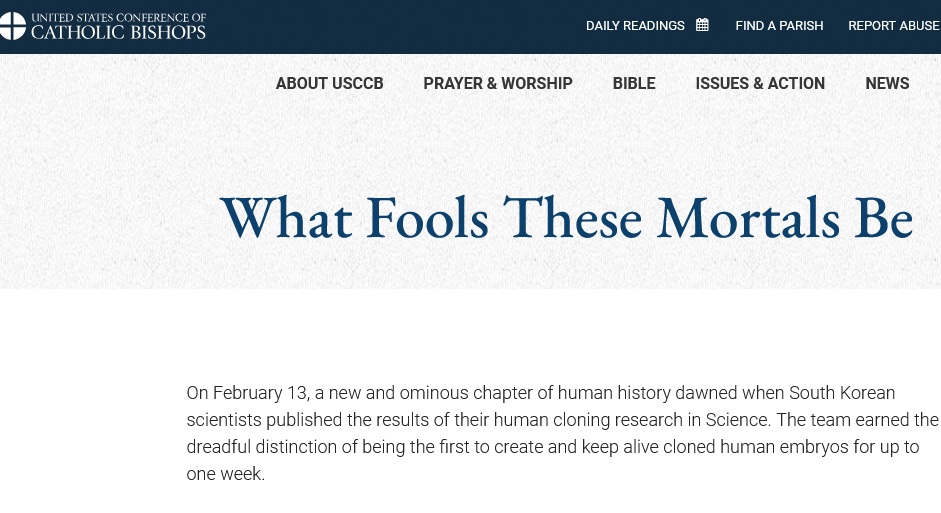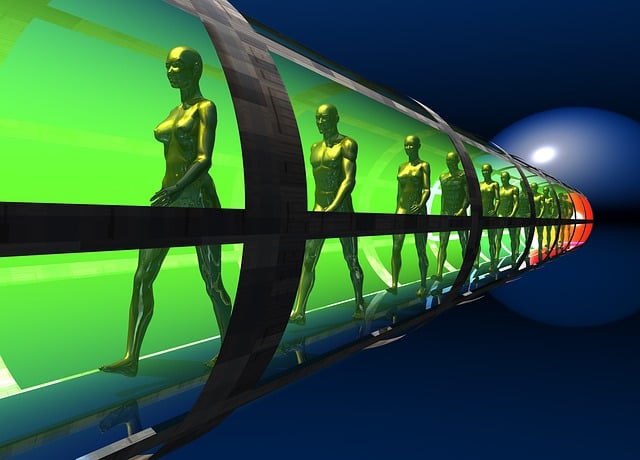If Barbra Streisand cloned her dog several years ago, could human clones be walking among us today? Amid rumors that clones of Joe Biden and Hillary Clinton walk amongst us, it’s a pertinent question for the times.
After Streisand lost her 14-year-old dog Sammie, a doctor took cells from inside the dog’s cheek, sent them to ViaGen Pets in Texas, and voila! Streisand now has a cloned curly-haired Coton de Tulear just like her original beloved pet. The Texas company actually was able to clone four dogs – too many for Streisand, who gave the rest away to friends.

Ms. Streisand and Sammie in 2004. Photo Credit Alberto Tolot.
Since 2005, ViaGen Pets, the self-proclaimed world leader in cloning pets, has cloned thousands of pets, at a price tag of $50,000 and up. They mostly clone dogs, but have also cloned horses, and even ferrets.
The Origins of Cloning
It all started back in 1962 when British biologist John Gurdon successfully cloned adult African clawed frogs from the intestinal cells of tadpoles of the same species. The work was so groundbreaking that Gurdon was awarded the Nobel Prize in Medicine.
Are you old enough to remember Dolly the sheep? In 1996, Dolly was the first cloned mammal to be born. Dolly gave birth the natural way to her own offspring, courtesy of her beau ram David. Although Dolly was later euthanized at age six due to lung tumors, a taxidermied Dolly resides at the National Museum of Scotland.

Dolly the Sheep with her first born lamb, called Bonnie. Photo courtesy of The Roslin Institute at The University of Edinburgh
Keep in mind that the DNA sequence is identical in all the body’s cells and cell types, and that this concept of genomic equivalence is what led to cloning.
But scientists stopped at sheep, right? I mean, they wouldn’t try to clone humans, would they? Yes, they would, and in fact, the first human embryo was cloned in America in 2001, just a few short years after the Dolly experiment.

Photo credit: Ulleo on Pixabay
The human embryos were created from the same method as Dolly, a method called somatic cell nuclear transfer. In this method, DNA from human skin cells was placed within enucleated human embryos. In that initial experiment, the most developed embryo grew to six cells, with scientists noting that the embryo would have to reach a 64-cell minimum for medical use. What kind of medical use, you ask? These scientists, led by Jose Cibelli, were careful to say that their intention was not to created cloned human beings, but instead create embryos for therapeutic use only, meaning trying to reach a viable embryo from which to harvest stem cells. One doctor who was a donor hoped that stem cells could be used one day to end his paralysis so that he could walk his daughter down the aisle when she married.
The above research was done at Massachusetts-based Advanced Cell Technology. That was over 20 years ago. In August 2001, both the House of Representatives and President G.W. Bush agreed to make it a federal crime to produce cloned embryos for research, but that legislation was delayed by the September 11 catastrophe. When Congress resumed the legislation process, the Senate did not pass this.
In 2004, South Korean veterinary scientist Dr. Hwang Woo Suk published a paper regarding the establishment of the first human embryonic stem cell using the “Dolly” method. In 1999, he had successfully cloned a dairy cow and quickly shifted to human research. He was all the rage in South Korea, receiving about $30 million in 2005 in research funds, named the first Supreme Scientist of South Korea, and having a stem cell research center established for him at Seoul National University Hospital.
The doctor created great controversy when he announced that he had used 242 human eggs, and 185 eggs in a subsequent 2005 paper. Hwang was later embroiled in scandal when these two papers were found to be fraudulent (falsification of medical data) and the doctor was involved in serious violations of medical ethics in collecting human eggs (242 for the 2004 paper and 185 for the 2005 paper), both purchasing them and forcing junior scientists to donate their eggs. This fraud “shook the world of science” at the time and Hwang’s fall from grace was sudden and unexpected.
The Hwang Affair, as it is known, sparked outrage around the world. The US Conference on Catholic Bishops wrote a great article about it, posing the ethical questions around “the most ominous chapter in human history.” Read it here.

Is cloning legal?
Shortly after the 2001 cloning of the first human embryo, that same week, the British government passed emergency legislation to ban reproductive cloning after a British high court could not find any existing law to prevent human cloning.
In the US, there is no federal legislation regarding cloning, but institutions that receive US federal funds are prohibited from experimental cloning. However, to be clear, there is currently no federal ban on human cloning.
It is important to distinguish between the two types of cloning: (1) Therapeutic cloning of embryos which are destroyed after stem cells are harvested and (2) Reproductive cloning for the purpose of implantation of the embryo.
Given that Roe v. Wade was overturned, the Supreme Court might rule the same way on cloning as it did on abortion law, meaning that decisions would revert to the states.
Human cloning is illegal in some states. Fifteen states have legislation regarding human cloning and 12 prohibit reproductive cloning. Six states — Arkansas, Indiana, Iowa, Michigan, and North and South Dakota also prohibit therapeutic cloning. Three states specifically prohibit the use of state funds in any form of human cloning. California, Connecticut, Maryland and New Jersey allow therapeutic cloning and condone research funded by state funds.
Amazingly, the majority of states have no specific legislation regarding cloning, but many have pending legislation.
Regarding regulation, the FDA quickly jumped into the Fray in 2001 after the first successful cloning experiment. FDA sent a letter to the research community “asserting regulatory authority over clinical research using cloning technology to create a human being.” The FDA advised that the regulatory process is required in order to initiate these investigations.
The FDA also has jurisdiction over cloned animals, and in 2008 approved the use of meat and milk from cloned animals like cattle, pigs and goats – any species traditionally used as food. No special labeling is required to identify such products. Despite the approval, FDA says that in practice, they don’t expect clones to enter the food supply, given the rarity and expense of producing such a clone. Some groups state that the FDA forced the decision through, despite the public outcry. They say the cloning process renders many unhealthy animals, and the best way to deal with those animals is to enter the food supply.
What is happening today?
The last publicly acknowledged scientific success was in 2013 when researchers created a human embryo that could successfully be used as a source of stem cells. The resulting stem cell lines were specific to the patient they came from, a baby with a rare genetic disorder. This was a success after the aforementioned Hwang controversy.
Has human cloning gone further? A Las Vegas company named Clonaid claimed in 2003 to have cloned two baby girls and a baby boy. The company was founded by a religious sect known as Rael. They believe that mankind was created by extraterrestrials through cloning and say they were given the mission to set up a cloning facility on Earth.
In late 2002, Clonaid said that a baby named Eve had been successfully cloned; Eve was an exact clone of her 31-year-old mother. Clonaid claims that the second girl was born to a lesbian couple in the Netherlands, and the third baby, the boy, was cloned from a Japanese couple’s comatose 2-year-old boy.
Clonaid has never produced Eve, nor evidence of Eve or the other babies after all this time. CEO Brigitte Boisselier was famous for having press conferences promising publications and photos of the babies within 5 days, but they never produced anything. Clonaid has never published their data, nor have they provided any evidence ordered by the US courts. Yet their website is still functioning; it even has checkboxes for GDPR regulation which was put in place in the last few years. They moved from the US to the Bahamas and in total claimed to have cloned 14 children.

Are we close to human cloning? The public narrative is “no”, with scientists noting the massive issues a human clone would have. Many cite animal cloning and the issues with ailments, including a high proclivity of arthritis and lung and liver problems in animal clones.
In 2017, a poll taken 20 years after Dolly’s cloning showed that over 80% of Americans felt that cloning humans was morally wrong. They felt less opposed to the cloning of animals, particularly when the cloning would be done to protect an endangered species.
Above I stated that institutions that receive US federal funds are prohibited from experimental cloning. Yet we know that institutions were prohibited from gain of function but they did it anyway. And we all definitely know, especially in the post-COVID era, that scientists don’t always adhere to moral guidelines. Gain of function research is a great example. As one interviewer aptly said, “Your scientists were so preoccupied with whether or not they could, they didn’t stop to think if they should.”
 Exactly. Sometimes what you don’t hear is more important. Despite having successfully cloned embryos over a decade ago, no one has gone further in cloning? While many countries abhor cloning, some do not. Do we really believe no one has tried it? After all, animal cloning is commonplace, and a Chinese group reported the births of the first monkey clones in 2018. We have new technologies like the CRISPR gene editing platform, and Chinese scientist He Jiankui created the world’s first gene edited CRISPER babies in 2019, which earned him a three-year prison sentence.
Exactly. Sometimes what you don’t hear is more important. Despite having successfully cloned embryos over a decade ago, no one has gone further in cloning? While many countries abhor cloning, some do not. Do we really believe no one has tried it? After all, animal cloning is commonplace, and a Chinese group reported the births of the first monkey clones in 2018. We have new technologies like the CRISPR gene editing platform, and Chinese scientist He Jiankui created the world’s first gene edited CRISPER babies in 2019, which earned him a three-year prison sentence.
Just because we haven’t heard about it doesn’t mean it hasn’t happened. And with that very large question mark hanging in the balance, can we really say with 100 percent certainty that human clones are not walking amongst us? You decide.
++++++++++++++++++++++++++++++++++++++++++++++++++++++++++++++++++
 Like what you’re reading on The Tenpenny Report?
Like what you’re reading on The Tenpenny Report?
Share this article with your friends. Help us grow.
Get more of Dr. Tenpenny’s voice of reason at her website.
Join our list here
Make a donation here (and thank you!)
++++++++++++++++++++++++++++++++++++++++++++++++++++++++++++++++++

Fed Up Texas Chick is a contributing writer for The Tenpenny Report. She’s a rocket scientist turned writer, having worked in the space program for many years. She is a seasoned medical writer and researcher who is fighting for medical freedom for all of us through her work.

